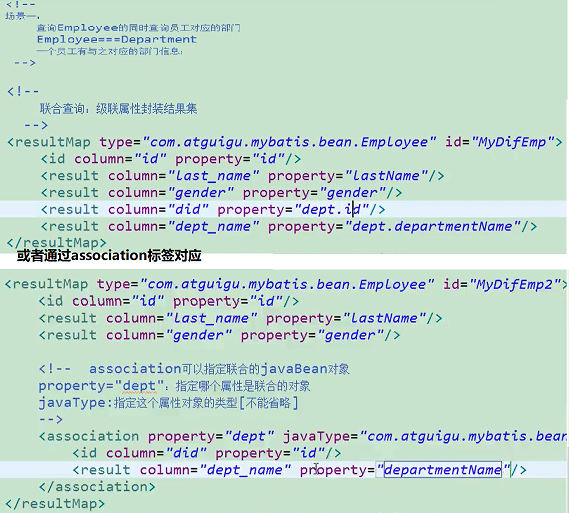关于sql操作
一 、定义SQL语句
- 【select】
属性介绍:
id :唯一的标识符.
parameterType:传给此语句的参数的全路径名或别名 例:com.test.poso.User或user
resultType :语句返回值类型或别名。注意,如果是集合,那么这里填写的
是集合的泛型,而不是集合本身(resultType 与resultMap 不能并用)
例子:
sql:
<select id="userList" parameterType="user" resultType="User">
select * from user where name =#{name}
</select>
- 【insert】
属性介绍:
id :唯一的标识符
parameterType:传给此语句的参数的全路径名或别名 例:com.test.poso.User
- 【delete】
例子:
<delete id="deleteUser" parameterType="int">
delete from user
where id = #{id}
</delete>
- 【update】
类似于insert
二、配置对象属性与查询结果集
- 【resultMap】
- 建立SQL查询结果字段与实体属性的映射关系信息
- 查询的结果集转换为java对象,方便进一步操作
- 将结果集中的列与java对象中的属性对应起来并将值填充进去
- 注意:与java对象对应的列不是数据库中表的列名,而是查询后结果集的列名
例:
<resultMap id="getStudentRM" type="EStudnet">
<id property="id" column="ID"/>
<result property="studentName" column="Name"/>
<result property="studentAge" column="Age"/>
</resultMap>
<select id="getStudent" resultMap="getStudentRM">
SELECT ID, Name, Age
FROM TStudent
</select>
resultMap标签属性:
id:该resultMap的标志
type:返回值的类名,此例中返回EStudnet类
resultMap标签下的子标签:
id:用于设置主键字段与领域模型属性的映射关系,此处主键为ID,对应id。
result:用于设置普通字段与领域模型属性的映射关系
【association】 一对一
【collection】 一对多
上面两个标签在resultmap中使用,可以通过嵌套结果集(即在标签里再通过result标签来对应属性),也可以通过另一接口方法查询后获得结果集。
resultMap标签自定义结果集
联合查询以及association通过嵌套结果集的使用
collection通过调用其他接口方法使用
相关属性:select:表示调用另一个接口的查询方法
column:将哪一列的值传递过去作为另一接口方法的参数 , 可以传递一个map类型的参数,例如:column="key1=column1, key2=column2}"
property:查询结果返回后封装到当前pojo哪一个属性。
fetchType: 设置延迟加载 ="lzay"
【discriminator】
鉴别器:mybatis可以使用discriminator判断某列的值,然后根据某列的值改变封装行为封装Employee:
如果查出的是女生:就把部门信息查询出来,否则不查询;如果是男生,把last_name这一列的值赋值给email;
例如:
<resultMap type="com.atguigu.mybatis.bean.Employee" id="MyEmpDis">
<id column="id" property="id" / >
<result column="last_name " property= "LastName"/>
<result column="email" property="email"/ >
<result column="gender" property="gender"/ >
<discriminator javaType="string" column="gender">
<!--女生resultType :指定封装的结果类型﹔不能缺少。resultMap-->
<case value="0" resultType= "com.atguigu.mybatis.bean. Emp
<association property="dept" select="com.atguigu.mybatis.dao.DepartmentMapper" column="d_id"></association>
</case>
<!--男生;如果是男生,把last_name这一列的值赋值给email; -->
<case value="1" resultType="com.atguigu.mybatis.bean.Em . Empl
<id column="id" property="id"/>
<result column="Last_name" property="LastName" />
<result column= "last_name" pPoperty="emaiL" />
<result column= "gender" property="gender" />
</case>
</discriminator>
</resultMap>
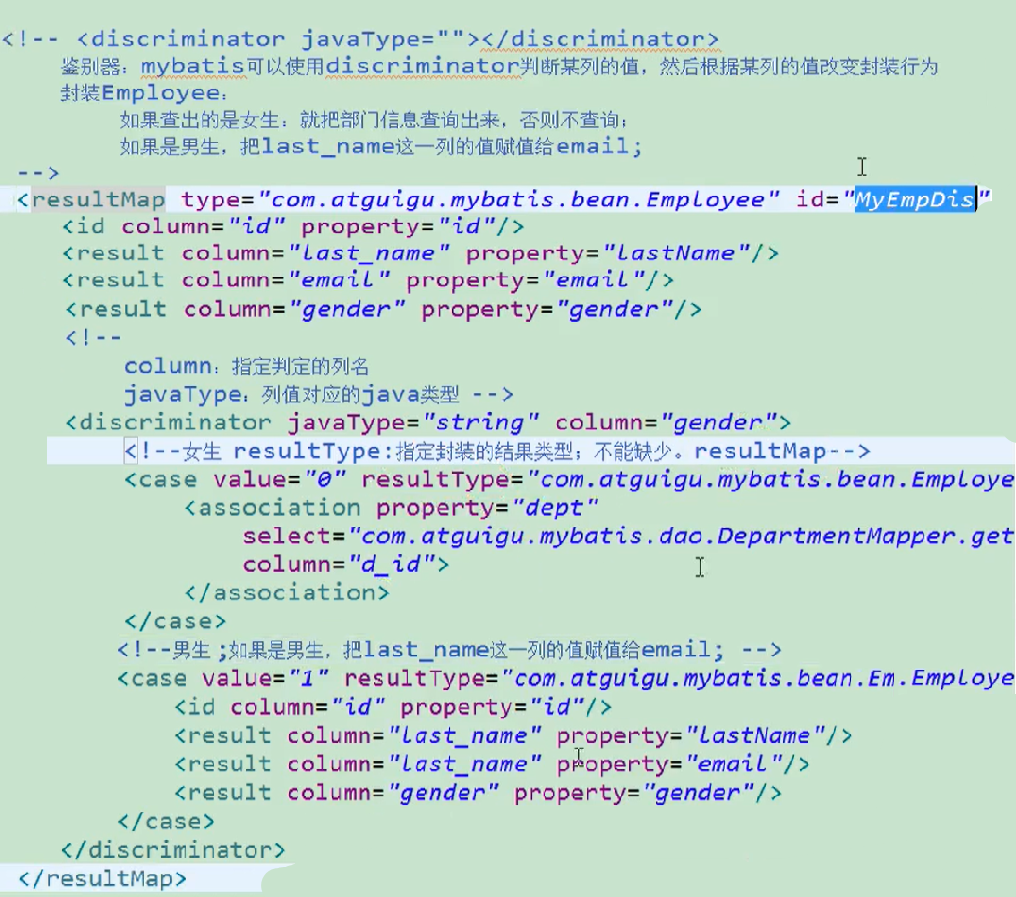
三、动态拼接SQL标签
- 【if】
通常用于WHERE语句中,通过判断参数值来决定是否使用某个查询条件, 他也经常用于UPDATE语句中判断是否更新某一个字段,还可以在INSERT语句中用来判断是否插入某个字段的值
例:
<select id="getStudentListLikeName" parameterType="StudentEntity" resultMap="studentResultMap">
SELECT * from STUDENT_TBL ST
WHERE ST.STUDENT_NAME LIKE CONCAT(CONCAT('%', #{studentName}),'%')
</select>
但是此时如果studentName是null或空字符串,此语句很可能报错或查询结果为空。此时我们使用if动态sql语句先进行判断,如果值为null或等于空字符串,我们就不进行此条件的判断。
修改为:
<select id=" getStudentListLikeName " parameterType="StudentEntity" resultMap="studentResultMap">
SELECT * from STUDENT_TBL ST
<if test="studentName!=null and studentName!='' ">
WHERE ST.STUDENT_NAME LIKE CONCAT(CONCAT('%', #{studentName}),'%')
</if>
</select>
- 【foreach】
主要用于构建in条件,他可以在sql中对集合进行迭代。如下:
<delete id="deleteBatch">
delete from user where id in
<foreach collection="array" item="id" index="index" open="(" close=")" separator=",">
#{id}
</foreach>
</delete>
假如说参数为----int[] ids = {1,2,3,4,5}----那么打印之后的SQL如下:
delete form user where id in (1,2,3,4,5)
foreach属性释义:
collection :collection属性值有三个(分别是list、array、map),分别对应的参数类型为(List、数组、map集合);上面传的参数为数组,所以值为array,但是如果接口在传递参数时使用了@Param注解,则可以使用自己定义的名称
item : 表示在迭代过程中每一个元素的别名
index :表示在迭代过程中每次迭代到的位置(下标)
open :前缀
close :后缀
separator :分隔符,表示迭代时每个元素之间以什么分隔
我们通常可以将之用到批量删除、添加等操作中。
- 【choose】
从多个选项中选择一个。MyBatis提供了choose 元素,按顺序判断when中的条件出否成立,如果有一个成立,则choose结束。
当choose中所有when的条件都不满则时,则执行 otherwise中的sql。
类似于Java 的switch 语句,choose为switch,when为case,otherwise则为default。if是与(and)的关系,而choose是或(or)的关系。
例:
<select id="getStudentListChooseEntity" parameterType="StudentEntity" resultMap="studentResultMap">
SELECT * from STUDENT_TBLST
<where>
<choose>
<when test="studentName!=null and studentName!='' ">
ST.STUDENT_NAME LIKE CONCAT(CONCAT('%', #{studentName}),'%')
</when>
<when test="studentSex!= null and studentSex!= '' ">
ST.STUDENT_SEX = #{studentSex}
</when>
<when test="studentBirthday!=null">
ST.STUDENT_BIRTHDAY = #{studentBirthday}
</when>
<when test="classEntity!=null and classEntity.classID !=null and classEntity.classID!='' ">
ST.CLASS_ID = #{classEntity.classID}
</when>
<otherwise>
1=1
</otherwise>
</choose>
</where>
</select>
四、格式化输出
- 【where】
<select id="getStudentListWhere" parameterType="StudentEntity" resultMap="studentResultMap">
SELECT * from STUDENT_TBL ST
WHERE
<if test="studentName!=null and studentName!='' ">
AND ST.STUDENT_NAME LIKE CONCAT(CONCAT('%', #{studentName}),'%')
</if>
<if test="studentSex!= null and studentSex!= '' ">
AND ST.STUDENT_SEX = #{studentSex}
</if>
</select>
如果上面例子,参数studentName为null或’’,则或导致此sql组合成“WHERE AND”之类的关键字多余的错误SQL。
这时我们可以使用where动态语句来解决。这个“where”标签会知道如果它包含的标签中有返回值的话,它就插入一个‘where’。此外,如果标签返回的内容是以AND 或OR 开头的,则它会剔除掉。
上面例子修改为:
<!-- 查询学生list,like姓名,=性别 -->
<select id="getStudentListWhere" parameterType="StudentEntity" resultMap="studentResultMap">
SELECT * from STUDENT_TBL ST
<where>
<if test="studentName!=null and studentName!='' ">
ST.STUDENT_NAME LIKE CONCAT(CONCAT('%', #{studentName}),'%')
</if>
<if test="studentSex!= null and studentSex!= '' ">
AND ST.STUDENT_SEX = #{studentSex}
</if>
</where>
</select>
- 【set】
当在update语句中使用if标签时,如果前面的if没有执行,则或导致逗号多余错误。
使用set标签可以将动态的配置SET 关键字,和剔除追加到条件末尾的任何不相关的逗号。
没有使用if标签时,如果有一个参数为null,都会导致错误,如下示例:
<!-- 更新学生信息 -->
<update id="updateStudent" parameterType="StudentEntity">
UPDATE STUDENT_TBL
SET STUDENT_TBL.STUDENT_NAME = #{studentName},
STUDENT_TBL.STUDENT_SEX = #{studentSex},
STUDENT_TBL.STUDENT_BIRTHDAY = #{studentBirthday},
STUDENT_TBL.CLASS_ID = #{classEntity.classID}
WHERE STUDENT_TBL.STUDENT_ID = #{studentID};
</update>
使用set+if标签修改后,如果某项为null则不进行更新,而是保持数据库原值。如下示例:
<!-- 更新学生信息 -->
<update id="updateStudent" parameterType="StudentEntity">
UPDATE STUDENT_TBL
<set>
<if test="studentName!=null and studentName!='' ">
STUDENT_TBL.STUDENT_NAME = #{studentName},
</if>
<if test="studentSex!=null and studentSex!='' ">
STUDENT_TBL.STUDENT_SEX = #{studentSex},
</if>
<if test="studentBirthday!=null ">
STUDENT_TBL.STUDENT_BIRTHDAY = #{studentBirthday},
</if>
<if test="classEntity!=null and classEntity.classID!=null and classEntity.classID!='' ">
STUDENT_TBL.CLASS_ID = #{classEntity.classID}
</if>
</set>
WHERE STUDENT_TBL.STUDENT_ID = #{studentID};
</update>
- 【trim】
trim(拼接字符串)是更灵活的去处多余关键字的标签,他可以实践where和set的效果。
trim标签相关属性说明:
prefix="" 前缀----trim标签体中是整个字符串拼串后的结果。prefix给拼串后的整个字符串加一个前缀
prefixOverrides="" 前缀覆盖----去掉整个字符串前面多余的什么字符
suffix="" 后缀----suffix给拼串后的整个字符串加一个后辍
suffixOverrides=" " 后缀覆盖----去掉整个字符串后面多余的什么字符
where例子的等效trim语句:
<!-- 查询学生list,like姓名,=性别 -->
<select id="getStudentListWhere" parameterType="StudentEntity" resultMap="studentResultMap">
SELECT * from STUDENT_TBL ST
<trim prefix="WHERE" prefixOverrides="AND|OR">
<if test="studentName!=null and studentName!='' ">
ST.STUDENT_NAME LIKE CONCAT(CONCAT('%', #{studentName}),'%')
</if>
<if test="studentSex!= null and studentSex!= '' ">
AND ST.STUDENT_SEX = #{studentSex}
</if>
</trim>
</select>
set例子的等效trim语句:
<!-- 更新学生信息 -->
<update id="updateStudent" parameterType="StudentEntity">
UPDATE STUDENT_TBL
<trim prefix="SET" suffixOverrides=",">
<if test="studentName!=null and studentName!="">
STUDENT_TBL.STUDENT_NAME = #{studentName},
</if>
<if test="studentSex!=null and studentSex!=" ">
STUDENT_TBL.STUDENT_SEX = #{studentSex},
</if>
<if test="studentBirthday!=null ">
STUDENT_TBL.STUDENT_BIRTHDAY = #{studentBirthday},
</if>
<if test="classEntity!=null and classEntity.classID!=null and classEntity.classID!='' ">
STUDENT_TBL.CLASS_ID = #{classEntity.classID}
</if>
</trim>
WHERE STUDENT_TBL.STUDENT_ID = #{studentID};
</update>
五、配置关联关系
- 【association】标签
一对一
association通常用来映射一对一的关系,例如,有个类user,对应的实体类如下:(getter,setter方法省略)
private String id;//主键
private String userName;//用户姓名
有个类Article,对应的实体类如下:
private String id;//主键
private String articleTitle;//文章标题
private String articleContent;//文章内容
如果我想查询一个用户的时候,也查到他写的一篇文章,可以怎样写呢?在类user加入一个属性article
private String id;//主键
private String userName;//用户姓名
private Article article;//新增的文章属性
2、mapper.xml 我在user类的mapper.xml这样配置
<resultMap id="userResultMap" type="test.mybatis.entity.User">
<id column="id" property="id" jdbcType="VARCHAR" javaType="java.lang.String"/>
<result column="userName" property="userName" jdbcType="VARCHAR" javaType="java.lang.String"/>
//这里把user的id传过去
<-- 属性:
select:表示调用另一个接口的查询方法
column:将那一列的值传递过去作为另一接口方法的参数
property:查询结果返回后封装到当前pojo哪一个属性。
-->
<association property="article" column="id" select="test.mybatis.dao.articleMapper.selectArticleByUserId"/>//test.mybatis.dao.articleMapper为命名空间
</resultMap>
同时,我的article对应的xml这样写:
<resultMap id="articleResultMap" type="test.mybatis.entity.Article">
<id column="id" property="id" jdbcType="VARCHAR" javaType="java.lang.String"/>
<result column="articleTitle" property="articleTitle" jdbcType="VARCHAR" javaType="java.lang.String"/>
<result column="articleContent" property="articleContent" jdbcType="VARCHAR" javaType="java.lang.String"/>
</resultMap>
(当然,这里还有查询user表的语句,省略)
同时,在article对应的xml有这样的select语句:
<select id="selectArticleByUserId" parameterType="java.lang.String" resultMap="ArticleResultMap">
select *
from tb_article where userId=#{userId}
</select>
- 【collection】标签
一对多
实体类增加对应属性
private String id;//主键
private String userName;//用户姓名
private List<Article> articleList;
userMapper.xml这样配置
<resultMap id="userResultMap" type="test.mybatis.entity.User">
<id column="id" property="id" jdbcType="VARCHAR" javaType="java.lang.String"/>
<result column="userName" property="userName" jdbcType="VARCHAR" javaType="java.lang.String"/>
//这里把user的id传过去
<collection property="articleList" column="id" select="test.mybatis.dao.articleMapper.selectArticleListByUserId" />
</resultMap>
以下省略,类同,Mybatis会把结果封装成List类型。
如果我还想通过Article表另一张表,比如文章中有个fk_id,也可以像上面这样重复配置,把fk_id当做与另一张表关联的参数,那时就可以通过用户查到文章,查到文章关联的另一张表了。
六、标签
【bind】
可以将OGNL表达式的值绑定到一个变量中,方便后来引用这个变量的值
属性:
name:相当于变量名
value:变量值,可以动态拼接,即可以写ognl表达式
使用时,直接使用变量即可,

【sql】
更多用于写sql语句的一部分,就像写在配置文件中的sql常量
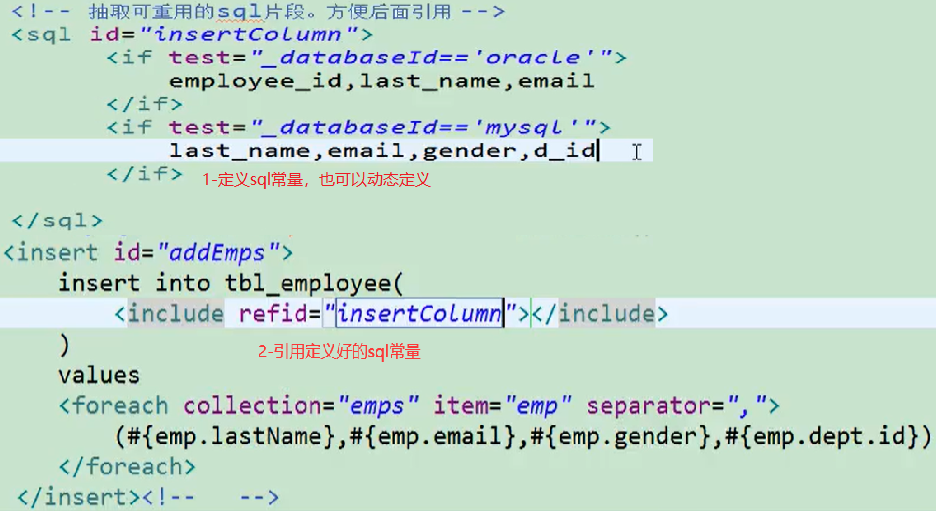
【include】
用于引用常量,也可以定义属性property,
sql标签内部就能使用自定义的属性
但取值的正确方式是${prop},不能使用#{prop}这种方式
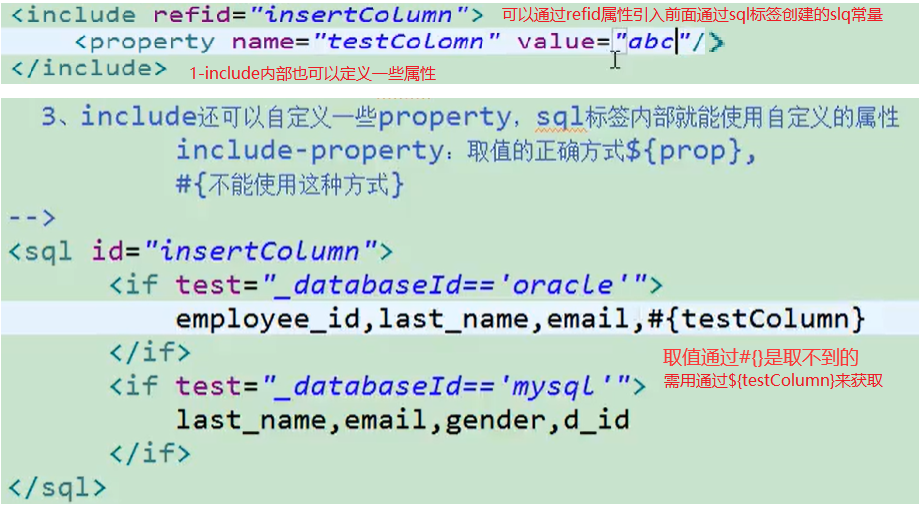
参考:https://blog.csdn.net/weixin_40950778/article/details/78655288
全局配置文件中的一些标签
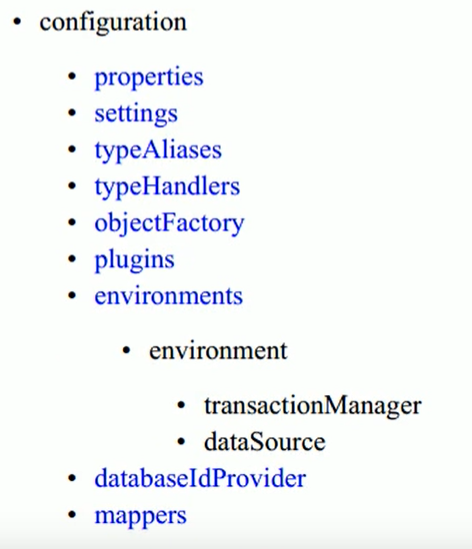
- 【properties】标签
引入外部properties配置文件的内容;
属性:
1---resource:引入类路径下的资源
2---url:引入网络路径或者磁盘路径下的资源
- 【settings】标签
用于设置mybatis的运行时行为
例如:缓存、懒加载、驼峰命名策略等等等。 - 【typeAliases】标签
对javabean进行重命名,重命名后在接口对应配置文件.xml中返回类型填写时可以不用填写全限定类名,不过推荐填写全限定类名
注意:如果用package 进行重命名,若指定包下的子包包含和父包一样类名的类,会报错。
1----对单个进行重命名
例如:
<typeAliases>
<typeAlias alias="Author" type="domain.blog.Author" />
<typeAlias alias="Blog" type="domain.blog.Blog" />
<typeAlias alias="Comment" type="domain.blog.Comment"/>
<typeAlias alias="Post" type="domain.blog.Post" />
<typeAlias alias="Section" type="domain.blog.section"/>
<typeAlias alias="Tag" type="domain.blog . Tag" />
</typeAliases>
2----对多个进行重命名
多个重命名就是指定包名,默认命名为类名小写
例如:
<typeAliases>
<package name="domain.blog" />
</typeAliases>
3----也可以在实体类上通过注解@alias实现类重命名
- 【databaseIdProvider】标签
mybatis根据不同的数据库厂商执行不同的执行sql
例如:
<databaseIdProvider type="DB_VENDOR">
<! --为不同的数据库厂商起别名–->
<property name="MysQL " value= "mysql" />
<property name="Oracle" value="oracle" / >
</databaseIdProvider>
在slq标签里通过databaseId="databaseIdProvider标签下数据库取的名称"指定
例如:
<select id="getEmpById" resultType="com.xiaoai.empUser" databaseId="mysql">
select *
from tbl_employee
where id = #{id}
</select>
- 【mapper】标签
引入接口对应slq映射文件.xml
<configuration>
<!-- 指定映射配置文件的位置,映射配置文件指的是每个dao独立的配置文件 -->
<mappers>
<mapper resource="com/xiaoai/dao/IUserDao.xml"/>
</mappers>
</configuration>
属性:
resource引用类路径下的sql映射文件
url 引用网路路径或磁盘下的sql映射文件
class 引用(注册)接口全限定类名: 1-如果用注解,就是引入接口类。2-如果是映射文件,映射文件必须和接口同名,并且放在接口同一目录下;
- 【package】标签
注意:mappers下的package和重命名标签中的package区别:一个指定实体类包,一个指定dao包
<mappers>
<!-- 用于指定Dao接口所在的包,当指定了之后就不需要再写mapper标签resource或者class属性了 -->
<package name="com.xiaoai.dao"/>
</mappers>

